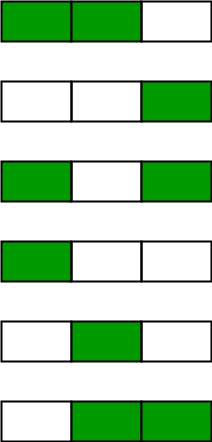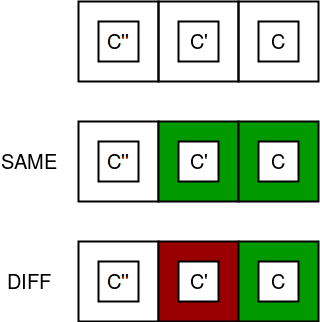Dada una valla con n postes yk colores, averigüe el número de formas de pintar la valla tal que como máximo 2 postes adyacentes tengan el mismo color. Como la respuesta puede ser grande, devuélvela módulo 10^9 + 7.
Ejemplos:
Entrada: n = 2 k = 4
Salida: 16
Explicación: Tenemos 4 colores y 2 postes.
Formas en que ambas publicaciones tienen el mismo color: 4
Formas en que ambas publicaciones tienen un color diferente: 4 (opciones para la 1.ª publicación) * 3 (opciones para la 2.ª publicación) = 12Entrada: n = 3 k = 2
Salida: 6La siguiente imagen muestra las 6 formas posibles de pintar 3 postes con 2 colores:
Considere la siguiente imagen en la que c, c’ y c” son los colores respectivos de las publicaciones i, i-1 e i-2.
De acuerdo con la restricción del problema, c = c’ = c” no es posible simultáneamente, así que c’ != c o c” != c o ambos. Hay k – 1 posibilidades para c’ != c y k – 1 para c” != c.
diff = no of ways when color of last two posts is different same = no of ways when color of last two posts is same total ways = diff + same for n = 1 diff = k, same = 0 total = k for n = 2 diff = k * (k-1) //k choices for first post, k-1 for next same = k //k choices for common color of two posts total = k + k * (k-1) for n = 3 diff = k * (k-1)* (k-1) //(k-1) choices for the first place // k choices for the second place //(k-1) choices for the third place same = k * (k-1) * 2 // 2 is multiplied because consider two color R and B // R R B or B R R // B B R or R B B c'' != c, (k-1) choices for it Hence we deduce that, total[i] = same[i] + diff[i] same[i] = diff[i-1] diff[i] = (diff[i-1] + diff[i-2]) * (k-1) = total[i-1] * (k-1)A continuación se muestra la implementación del problema:
C++
// C++ program for Painting Fence Algorithm// optimised version#include <bits/stdc++.h>usingnamespacestd;// Returns count of ways to color k postslongcountWays(intn,intk){longdp[n + 1];memset(dp, 0,sizeof(dp));longlongmod = 1000000007;dp[1] = k;dp[2] = k * k;for(inti = 3; i <= n; i++) {dp[i] = ((k - 1) * (dp[i - 1] + dp[i - 2])) % mod;}returndp[n];}// Driver codeintmain(){intn = 3, k = 2;cout << countWays(n, k) << endl;return0;}Java
// Java program for Painting Fence Algorithmimportjava.util.*;classGfG {// Returns count of ways to color k posts// using k colorsstaticlongcountWays(intn,intk){// To store results for subproblemslongdp[] =newlong[n +1];Arrays.fill(dp,0);intmod =1000000007;// There are k ways to color first postdp[1] = k;// There are 0 ways for single post to// violate (same color_ and k ways to// not violate (different color)intsame =0, diff = k;// Fill for 2 posts onwardsfor(inti =2; i <= n; i++) {// Current same is same as previous diffsame = diff;// We always have k-1 choices for next postdiff = (int)(dp[i -1] * (k -1));diff = diff % mod;// Total choices till i.dp[i] = (same + diff) % mod;}returndp[n];}// Driver codepublicstaticvoidmain(String[] args){intn =3, k =2;System.out.println(countWays(n, k));}}// This code contributed by Rajput-JiPython3
# Python3 program for Painting Fence Algorithm# optimised version# Returns count of ways to color k postsdefcountWays(n, k):dp=[0]*(n+1)total=kmod=1000000007dp[1]=kdp[2]=k*kforiinrange(3,n+1):dp[i]=((k-1)*(dp[i-1]+dp[i-2]))%modreturndp[n]# Driver coden=3k=2(countWays(n, k))# This code is contributed by shubhamsingh10C#
// C# program for Painting Fence AlgorithmusingSystem;publicclassGFG{// Returns count of ways to color k posts// using k colorsstaticlongcountWays(intn,intk){// To store results for subproblemslong[] dp =newlong[n + 1];Array.Fill(dp, 0);intmod = 1000000007;// There are k ways to color first postdp[1] = k;// There are 0 ways for single post to// violate (same color_ and k ways to// not violate (different color)intsame = 0, diff = k;// Fill for 2 posts onwardsfor(inti = 2; i <= n; i++){// Current same is same as previous diffsame = diff;// We always have k-1 choices for next postdiff = (int)(dp[i - 1] * (k - 1));diff = diff % mod;// Total choices till i.dp[i] = (same + diff) % mod;}returndp[n];}// Driver codestaticpublicvoidMain(){intn = 3, k = 2;Console.WriteLine(countWays(n, k));}}// This code is contributed by avanitrachhadiya2155JavaScript
<script>// Javascript program for Painting Fence Algorithm// Returns count of ways to color k posts// using k colorsfunctioncountWays(n, k){// To store results for subproblemslet dp =newArray(n + 1);dp.fill(0);let mod = 1000000007;// There are k ways to color first postdp[1] = k;// There are 0 ways for single post to// violate (same color_ and k ways to// not violate (different color)let same = 0, diff = k;// Fill for 2 posts onwardsfor(let i = 2; i <= n; i++){// Current same is same as previous diffsame = diff;// We always have k-1 choices for next postdiff = (dp[i - 1] * (k - 1));diff = diff % mod;// Total choices till i.dp[i] = (same + diff) % mod;}returndp[n];}let n = 3, k = 2;document.write(countWays(n, k));// This code is contributed by divyeshrabadiya07.</script>Producción6Optimización del espacio:
podemos optimizar la solución anterior para usar una variable en lugar de una tabla.
A continuación se muestra la implementación del problema:C++
// C++ program for Painting Fence Algorithm#include <bits/stdc++.h>usingnamespacestd;// Returns count of ways to color k posts// using k colorslongcountWays(intn,intk){// There are k ways to color first postlongtotal = k;intmod = 1000000007;// There are 0 ways for single post to// violate (same color) and k ways to// not violate (different color)intsame = 0, diff = k;// Fill for 2 posts onwardsfor(inti = 2; i <= n; i++) {// Current same is same as previous diffsame = diff;// We always have k-1 choices for next postdiff = total * (k - 1);diff = diff % mod;// Total choices till i.total = (same + diff) % mod;}returntotal;}// Driver codeintmain(){intn = 3, k = 2;cout << countWays(n, k) << endl;return0;}Java
// Java program for Painting Fence AlgorithmclassGFG {// Returns count of ways to color k posts// using k colorsstaticlongcountWays(intn,intk){// There are k ways to color first postlongtotal = k;intmod =1000000007;// There are 0 ways for single post to// violate (same color_ and k ways to// not violate (different color)intsame =0, diff = k;// Fill for 2 posts onwardsfor(inti =2; i <= n; i++) {// Current same is same as previous diffsame = diff;// We always have k-1 choices for next postdiff = (int)total * (k -1);diff = diff % mod;// Total choices till i.total = (same + diff) % mod;}returntotal;}// Driver codepublicstaticvoidmain(String[] args){intn =3, k =2;System.out.println(countWays(n, k));}}// This code is contributed by Mukul SinghPython3
# Python3 program for Painting# Fence Algorithm# Returns count of ways to color# k posts using k colorsdefcountWays(n, k) :# There are k ways to color first posttotal=kmod=1000000007# There are 0 ways for single post to# violate (same color_ and k ways to# not violate (different color)same, diff=0, k# Fill for 2 posts onwardsforiinrange(2, n+1) :# Current same is same as# previous diffsame=diff# We always have k-1 choices# for next postdiff=total*(k-1)diff=diff%mod# Total choices till i.total=(same+diff)%modreturntotal# Driver codeif__name__=="__main__":n, k=3,2(countWays(n, k))# This code is contributed by RyugaC#
// C# program for Painting Fence AlgorithmusingSystem;classGFG {// Returns count of ways to color k posts// using k colorsstaticlongcountWays(intn,intk){// There are k ways to color first postlongtotal = k;intmod = 1000000007;// There are 0 ways for single post to// violate (same color_ and k ways to// not violate (different color)longsame = 0, diff = k;// Fill for 2 posts onwardsfor(inti = 2; i <= n; i++) {// Current same is same as previous diffsame = diff;// We always have k-1 choices for next postdiff = total * (k - 1);diff = diff % mod;// Total choices till i.total = (same + diff) % mod;}returntotal;}// Driver codestaticvoidMain(){intn = 3, k = 2;Console.Write(countWays(n, k));}}// This code is contributed by DrRoot_PHP
<?php// PHP program for Painting Fence Algorithm// Returns count of ways to color k// posts using k colorsfunctioncountWays($n,$k){// There are k ways to color first post$total=$k;$mod= 1000000007;// There are 0 ways for single post to// violate (same color_ and k ways to// not violate (different color)$same= 0;$diff=$k;// Fill for 2 posts onwardsfor($i= 2;$i<=$n;$i++){// Current same is same as previous diff$same=$diff;// We always have k-1 choices for next post$diff=$total* ($k- 1);$diff=$diff%$mod;// Total choices till i.$total= ($same+$diff) %$mod;}return$total;}// Driver code$n= 3;$k= 2;echocountWays($n,$k) ."\n";// This code is contributed by ita_c?>JavaScript
<script>// JavaScript program for Painting Fence Algorithm// Returns count of ways to color k posts// using k colorsfunctioncountWays(n, k){// There are k ways to color first postlet total = k;let mod = 1000000007;// There are 0 ways for single post to// violate (same color_ and k ways to// not violate (different color)let same = 0, diff = k;// Fill for 2 posts onwardsfor(let i = 2; i <= n; i++) {// Current same is same as previous diffsame = diff;// We always have k-1 choices for next postdiff = total * (k - 1);diff = diff % mod;// Total choices till i.total = (same + diff) % mod;}returntotal;}let n = 3, k = 2;document.write(countWays(n, k));</script>Producción6Este artículo es una contribución de Aditi Sharma . Si te gusta GeeksforGeeks y te gustaría contribuir, también puedes escribir un artículo usando write.geeksforgeeks.org o enviar tu artículo por correo a review-team@geeksforgeeks.org. Vea su artículo que aparece en la página principal de GeeksforGeeks y ayude a otros Geeks.
Escriba comentarios si encuentra algo incorrecto o si desea compartir más información sobre el tema tratado anteriormente.
Publicación traducida automáticamente
Artículo escrito por GeeksforGeeks-1 y traducido por Barcelona Geeks. The original can be accessed here. Licence: CCBY-SA

